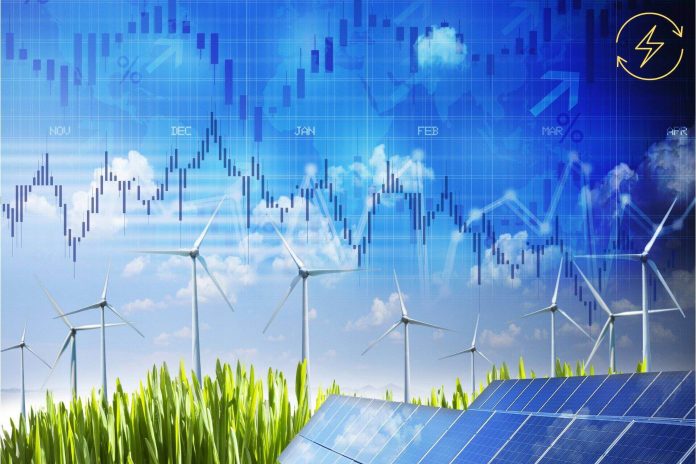Croatia has achieved an excellent electrical energy balance over the past few months, thanks to an increase in renewable energy capacity, exporting more electricity than it imported. It seemed likely that we would end the year with an export balance for the first time in more than twenty years. However, a few days ago, there was a malfunction at the Krško nuclear power plant. According to the latest announcements, due to the fault repair, the plant will be closed for more than thirty days. Because of this, Slovenia is forced to import electrical energy, although a good part will be covered by domestic production from hydro and solar power plants.
The share of electrical energy that Croatia obtains and uses from the nuclear power plant covers about 15% of Croatian needs. We will have to import this deficit. But if we had developed enough new renewable capacities in time, such extraordinary situations would not be a problem. This is just another indicator of how unpredictable and fragile the market is and how important it is to develop domestic, renewable energy sources as quickly as possible.
This report continues to provide an overview of the electrical energy movements for September and the first nine months of this year and can serve all those who want to be informed about the work and development of the Croatian electric power system.
Electrical energy movements in September
In September, there was a significant increase in the production of solar power plants due to the commissioning of new production capacities, as well as good production from wind power plants (wind farms ZD2P and ZD3P were in trial operation), but also reduced production from geothermal plants. In September, solar power plants achieved a share of 1.9% in the production mix. September is also the first month in which wind, sun, biomass, biogas, and geothermal energy surpassed the production of our hydroelectric power plants. However, the largest production of electrical energy in September was achieved by fossil fuel power plants.

The report highlights the very low production of hydroelectric power plants in September, especially pumped storage hydroelectric power plants from water inflow and the emptying of accumulations. On the other hand, the Plomin thermal power plant had high production of 139 GWh during September, and gas-fired power plants also had stable production during the month, providing system services and balancing due to lower production from hydroelectric power plants. RHE Velebit worked intensively in pump-turbine operation.
Due to the balancing of the hourly balance in September, we had to purchase 151 GWh of electrical energy and sold 59 GWh. Thus, we ended September as importers of 92 GWh of electrical energy.

Wind farms achieved above-average production. Their total production in September amounted to 225,850 MWh. The capacity utilization factor was 28.7%, which is an increase compared to the previous period when the average for September from 2011 to 2022 was 24.3%.

In September, all technologies achieved very good market prices, especially thermal power plants and hydroelectric power plants. Our production, trade, and system operators successfully place the production of HE and TE at the highest market prices and buy energy when that price is low, which resulted in a higher value than the market by 3 million euros in September. Wind farms also achieved a higher value compared to the market price of 273 thousand euros in September.

The exception is the production of solar power plants which place their maximum production when the market price is lowest during the day, and they achieved a lower value compared to the market price in the amount of 269 thousand euros in September.
Energy movements in the first nine months of 2023
The total electricity turnover in the first nine months of this year amounted to 19,358 GWh, of which the demand was 14,682 GWh, and the balance of exchange with foreign countries 894 GWh. That is, the planned export was 1,351 GWh, and the planned import was 457 GWh. Thus, in the first nine months, we successfully sold surpluses of 894 GWh of electrical energy.

The total production of electrical energy at the threshold of power plants in Croatia in the first nine months amounted to 12,413 GWh, of which non-renewable sources produced 3,846 GWh or 31.0%, and renewables 8,567 GWh or 69.0%.
We consumed about 13,788 GWh of electrical energy, where the domestic consumption was 13,713 GWh, and the consumption of the reversible hydroelectric power plant (RHE) for water pumping was about 75 GWh. We also consumed 2,269 GWh produced by the Krško nuclear power plant.

Renewable energy sources participated in the available energy in the first nine months of this year with 58.3% (hydroelectric power plants 39.4%, other renewables 18.9%), non-renewable 26.2%, and NE Krško with 15.5%. It is expected that other renewable energy sources will achieve a share of 20% of available energy this year.
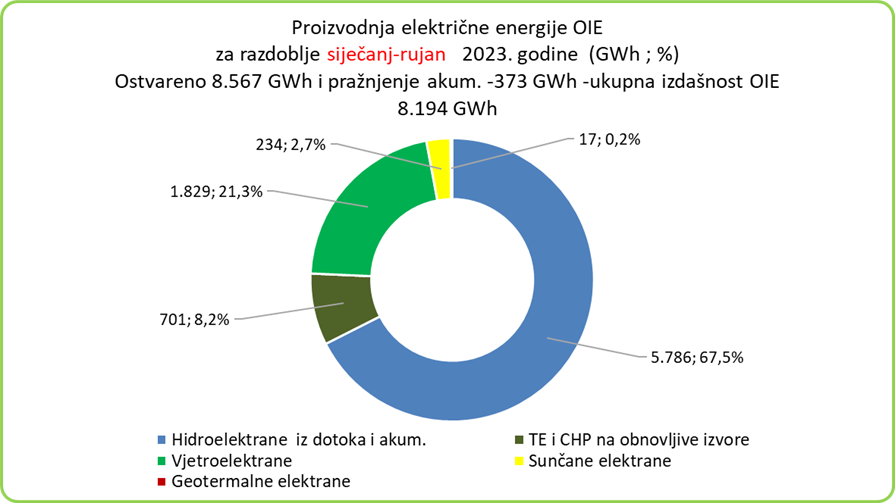
The total production of renewable energy sources in the first nine months was 8,567 GWh and there was a discharge of accumulations compared to the beginning of the year in the amount of 373 GWh, so the total yield/productivity of renewable energy sources was 8,194 GWh.

From the figure below, it is clear that September is the first month this year in which ‘new renewable energy sources’ produced more electrical energy than our hydroelectric power plants.
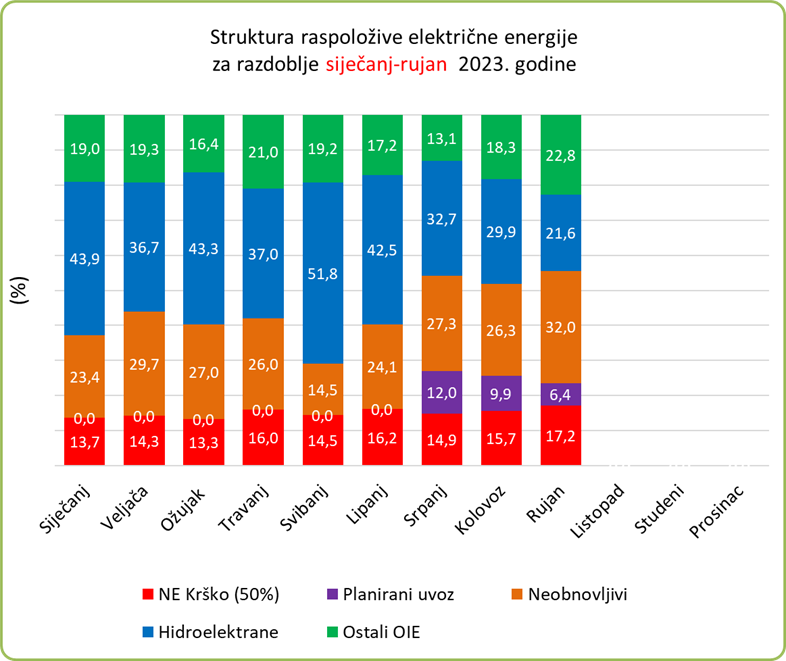
If we compare the first nine months of this year with the nine months of last year, very favorable energy indicators are visible. During the observed period, NE Krško produced 52 GWh more electrical energy, and the production of renewable sources is higher by 2,397 GWh. The most significant is the production of hydroelectric power plants from water inflow and accumulations, which was higher by 2,212 GWh. The production of wind farms in the first nine months of this year was 73 GWh higher than the production in the nine months of last year, and in the same period, the production of solar power plants was higher by 167 GWh.

In the first nine months of this year, we sold 894 GWh of electrical energy, while in the same period last year we had to buy 1,826 GWh. This is a difference of 2,720 GWh, which is a significant gain, especially when considering market prices in the observed periods. Transit of electrical energy for other regulatory areas via the transmission network decreased by 641 GWh in the observed period.
The total production of hydroelectric power plants at the threshold for the first nine months of this year amounted to 5,845 GWh, of which 59 GWh from the pumped water of RHE (non-renewable part).
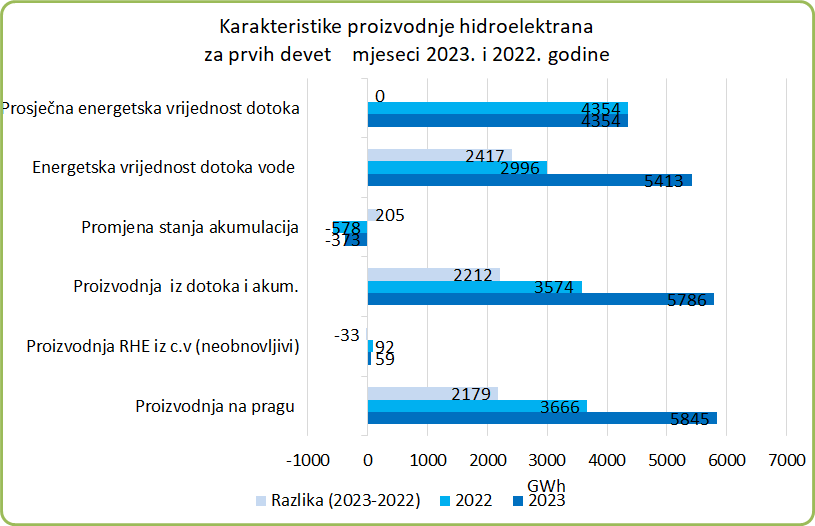
The energy value of water inflow for hydroelectric power plants for the first nine months of this year amounted to 5,413 GWh and was higher by 2,417 GWh compared to the same period last year.
Great growth of solar this year
Solar power plants achieved 1.9% in the production mix in September.

Croatia had 172 MW of installed solar power plant capacities on August 1, 2022, and this year on the same date 353 MW. This is more than double the increase, which just shows that solar energy is experiencing a boom in Croatia. The latest data from HEP-ODS shows a further increase in installed capacities, so on October 1, we had 408 MW of solar power plants. If we continue at this pace, we could start the new year with 500 MW of installed solar capacity.
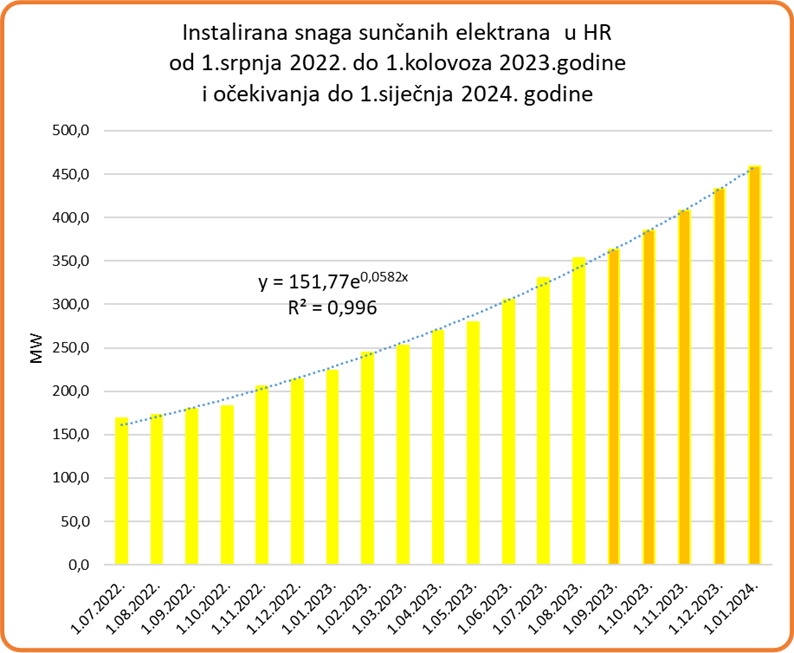
In seven months of this year, 129.5 MW of solar power plants were installed, or an average of 18.5 MW per month or 611 kW per day. Assuming an average power of 400 W per panel, 1,528 panels were installed daily.

Looking at the period from 2016 to 2023, a significant jump in the production of solar power plants this year is visible, as well as monthly (seasonal) oscillations due to changes in insolation. In the annual balance, Croatia achieves 70% of the production of solar power plants in the period from April to September.
Publicly published data on the pages: HEP, HOPS, ODS, HROTE, CROPEX, NE Krško, ENTSO, DZS, RTE France, RED Electrica, World Data, IEA, EEX, EPEX, IRENA were used to create this analysis.


